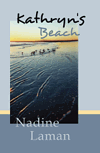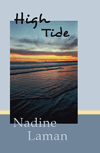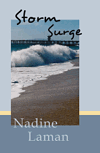The beginning of a story is actually quite short. It is important because of its role to engage the reader (literary agent or acquisition editor) and make them crave more. It has to be interesting. It has to be something the reader can relate to, even if it is set in a different time period or location than the reader has directly experienced. And it has to move the story forward. (It has to be compelling.)
That is where the middle begins - from that set of the first act. (In Kathryn's Beach, the middle begins when she begins her return to California.) The middle swells with the ongoing collection of secondary characters and secondary story lines (sub-plots) that all lead to the finale.
Whether the characters are compadres of the main character or complications (antagonists), they need to be added naturally in the flow of the story. The 'other' characters, the cast of extras, come and go in the scenes as bridges, as someone who is a 'prop' for an action, as reality builders - like being in the middle of the Macy Parade without ever mentioning the croud is unbelievable.
While there are little morals or messages in every book, if you search for them, they can't be the story. The story has to be about drama and human drama resonates best with the reader because they are, after all, human.
The story has to continue to move forward. That's what people mean when they say a book is a page-turner. When the writer stops to describe something at length or go off on a side adventure, the story stops. That is the point where the reader can lay down the book and go get something done.
This is where experienced writers talk about showing rather than telling. Look back on my post review of the ms by Cathy Cole, there is an example of showing and telling. Actually, some telling is not only okay, it is necessary.
Another element of storytelling is pacing. This is one of my favorite writing elements. Just like it is important to vary the length of sentences, paragraphs, and even chapters, changing the pace keeps the work from becoming monotonous...ie, boring.
Think of A Tale of Two Cities by Charles Dickens. (Sorry to use a beginning as an example) That whole intro would have been horribly boring if the pace hadn't have been quick. The way Dickens resolved that was with short sentences and a sing-song rhythm to it.
"It was the best of times. It was the worst of times." Dickens only changed one word in those two sentences, so the paces moved quickly. And of course, I like literary writing styles - I'm all jazzed when I read that excerpt (extract).
So the middle is moving along, solving problems, adding two and solving one, but solving them to propel the work forward to the end. It is developing the characters to make them real and give them personalities.
By name, the middle is the least discussed section of the story because we talk about writing in general. Yet, that is where the drama unfolds and the literary devices are used. (Google: Literary Devices). I think it is the literary devices that make the difference between telling a story and being a storyteller.
Next...more middle.
Showing/telling, look here: http://nadinelaman.blogspot.com/2010/01/buzz-buzz-ms-buzz.html
Google "pacing in writing" for more info. Here is one link I like: http://www.grokdotcom.com/rhythmandpacinginwriting.htm
Friday, January 29, 2010
Subscribe to:
Post Comments (Atom)

 When Paul Fenton stops for breakfast in a small town, he gets more than he bargained for in the process.
When Paul Fenton stops for breakfast in a small town, he gets more than he bargained for in the process.
 When two-hundred-year-old human remains are discovered on one of Neptune's moons, Earth's history falls into question.
When two-hundred-year-old human remains are discovered on one of Neptune's moons, Earth's history falls into question.
 Emily's husband persuades her to try thalidomide to ease her symptoms as she is unaware of the devastating effects.
Emily's husband persuades her to try thalidomide to ease her symptoms as she is unaware of the devastating effects.
 Who is the women's shelter bomber? Melissa Ryan suspects that her husband knows.
Who is the women's shelter bomber? Melissa Ryan suspects that her husband knows.
 Further developments with the Wilder family.
Further developments with the Wilder family.
 A hidden past shakes the O'Donovan family to its core
A hidden past shakes the O'Donovan family to its core
 A swirl of emotion and choice, set in Cape Town, South Africa
A swirl of emotion and choice, set in Cape Town, South Africa
 Love is a constant, but it comes at a price.
Love is a constant, but it comes at a price.
 When the road ahead is unclear, sometimes you have to rely on trust.
When the road ahead is unclear, sometimes you have to rely on trust.
 The struggle between good and evil is ages old. It gets all the more complicated when the good guys aren't all good and the bad guys have redeeming qualities.
The struggle between good and evil is ages old. It gets all the more complicated when the good guys aren't all good and the bad guys have redeeming qualities.
 Story of a land mothering two races of people – the light-skinned and the dark-skinned.
Story of a land mothering two races of people – the light-skinned and the dark-skinned.
 A gifted Ukrainian ballerina comes into possession of a mysteriously coded address book.
A gifted Ukrainian ballerina comes into possession of a mysteriously coded address book.
 Six passengers' lives change for better or worse after they arrive in Honiton.
Six passengers' lives change for better or worse after they arrive in Honiton.
 Resilience and love in a harsh and unforgiving age
Resilience and love in a harsh and unforgiving age
 Kathryn's Beach
Kathryn's Beach High Tide
High Tide Storm Surge
Storm Surge
This comment has been removed by a blog administrator.
ReplyDeleteThanks for the comment -- hope it was something good.
ReplyDeleteHated to delete your comment, but if you don't write in English, that's what will happen. Please try again and remember to comment in the language of the blog.
ReplyDeleteHello my friend,
ReplyDeleteYou'll probably be interested to know I was diagnosed with dyslexia, dyspraxia and dyscalculia yesterday :), which explains a lot. I've given you an award over on my Chez Aspie blog. xo
Goodness DJ, it must be catching! Seriously, hope you feel better knowing.
ReplyDelete